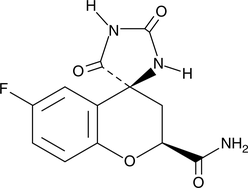Chemicals
Showing 19501–19650 of 41137 results
-
FFN-102 is a fluorescent false neurotransmitter (FFN) that is a substrate for the dopamine transporter (DAT) and vesicular monoamine transporter 2 (VMAT2).{38320} It is a pH-dependent fluorescent probe that labels dopamine cell bodies, axons, and presynaptic terminals. It can also be used to monitor dopamine exocytosis.{38319} It has a pKa of 6.2 and displays pH-dependent excitation spectra of 340 and 370 nm at pH 5 and 7.4, respectively, which correspond to vesicular and cytoplasmic pH values.{38320} The emission spectrum of FFN-102 is pH-independent at 453 nm, but the intensity of emission is pH-dependent with a higher intensity at a pH of 7.4. FFN-102 inhibits DAT (13.6% at a concentration of 10 µM) and the serotonin (5-HT) receptor subtype 5-HT2c (Ki = ~3 µM) but does not bind to 37 other central nervous system receptors and transporters, including dopamine receptors, up to a concentration of 10 µM.{38320}
Brand:CaymanSKU:21458 -Out of stock
Hypoxia-inducible factor (HIF) prolyl hydroxylase (PHD) enzymes act as central gatekeepers of post-transcriptional and transcriptional adaptation to hypoxia, oxidative stress, and excitotoxicity. FG-2216 is an orally active PHD2 inhibitor (IC50 = 3.9 µM) that stabilizes HIF-α.{30802} It has been shown to reversibly stimulate erythropoietin secretion at 100 µM in vitro and to increase hematocrit, red blood cell count, and hemoglobin levels at 50 mg/kg in mice.{30802,25021}
Brand:CaymanSKU:-Available on backorder
Hypoxia-inducible factor (HIF) prolyl hydroxylase (PHD) enzymes act as central gatekeepers of post-transcriptional and transcriptional adaptation to hypoxia, oxidative stress, and excitotoxicity. FG-2216 is an orally active PHD2 inhibitor (IC50 = 3.9 µM) that stabilizes HIF-α.{30802} It has been shown to reversibly stimulate erythropoietin secretion at 100 µM in vitro and to increase hematocrit, red blood cell count, and hemoglobin levels at 50 mg/kg in mice.{30802,25021}
Brand:CaymanSKU:-Available on backorder
Hypoxia-inducible factor (HIF) prolyl hydroxylase (PHD) enzymes act as central gatekeepers of post-transcriptional and transcriptional adaptation to hypoxia, oxidative stress, and excitotoxicity. FG-2216 is an orally active PHD2 inhibitor (IC50 = 3.9 µM) that stabilizes HIF-α.{30802} It has been shown to reversibly stimulate erythropoietin secretion at 100 µM in vitro and to increase hematocrit, red blood cell count, and hemoglobin levels at 50 mg/kg in mice.{30802,25021}
Brand:CaymanSKU:-Available on backorder
Hypoxia-inducible factor (HIF) prolyl hydroxylase (PHD) enzymes act as central gatekeepers of post-transcriptional and transcriptional adaptation to hypoxia, oxidative stress, and excitotoxicity. FG-2216 is an orally active PHD2 inhibitor (IC50 = 3.9 µM) that stabilizes HIF-α.{30802} It has been shown to reversibly stimulate erythropoietin secretion at 100 µM in vitro and to increase hematocrit, red blood cell count, and hemoglobin levels at 50 mg/kg in mice.{30802,25021}
Brand:CaymanSKU:-Available on backorder
The hypoxia-inducible factor (HIF) pathway alters gene expression in response to low oxygen tension. Under normoxic conditions, HIF-specific prolyl hydroxylases (HIF-PHs) initiate the degradation of oxygen-sensitive HIF isoforms. As 2-oxoglutarate (2-OG) is a required co-factor for HIF-PH activity, analogs of 2-OG may inhibit HIF-PH and prevent HIF turnover.{25022} FG-4592 is an analog of 2-OG that has been developed as an inhibitor of HIF-PHs. While little has been published regarding the actions of this compound, similar HIF-PH inhibitors suppress HIF degradation and in this way induce erythropoietin expression, promoting erythropoiesis or preventing anemia in vivo.{25021}
Brand:CaymanSKU:-The hypoxia-inducible factor (HIF) pathway alters gene expression in response to low oxygen tension. Under normoxic conditions, HIF-specific prolyl hydroxylases (HIF-PHs) initiate the degradation of oxygen-sensitive HIF isoforms. As 2-oxoglutarate (2-OG) is a required co-factor for HIF-PH activity, analogs of 2-OG may inhibit HIF-PH and prevent HIF turnover.{25022} FG-4592 is an analog of 2-OG that has been developed as an inhibitor of HIF-PHs. While little has been published regarding the actions of this compound, similar HIF-PH inhibitors suppress HIF degradation and in this way induce erythropoietin expression, promoting erythropoiesis or preventing anemia in vivo.{25021}
Brand:CaymanSKU:-The hypoxia-inducible factor (HIF) pathway alters gene expression in response to low oxygen tension. Under normoxic conditions, HIF-specific prolyl hydroxylases (HIF-PHs) initiate the degradation of oxygen-sensitive HIF isoforms. As 2-oxoglutarate (2-OG) is a required co-factor for HIF-PH activity, analogs of 2-OG may inhibit HIF-PH and prevent HIF turnover.{25022} FG-4592 is an analog of 2-OG that has been developed as an inhibitor of HIF-PHs. While little has been published regarding the actions of this compound, similar HIF-PH inhibitors suppress HIF degradation and in this way induce erythropoietin expression, promoting erythropoiesis or preventing anemia in vivo.{25021}
Brand:CaymanSKU:-The hypoxia-inducible factor (HIF) pathway alters gene expression in response to low oxygen tension. Under normoxic conditions, HIF-specific prolyl hydroxylases (HIF-PHs) initiate the degradation of oxygen-sensitive HIF isoforms. As 2-oxoglutarate (2-OG) is a required co-factor for HIF-PH activity, analogs of 2-OG may inhibit HIF-PH and prevent HIF turnover.{25022} FG-4592 is an analog of 2-OG that has been developed as an inhibitor of HIF-PHs. While little has been published regarding the actions of this compound, similar HIF-PH inhibitors suppress HIF degradation and in this way induce erythropoietin expression, promoting erythropoiesis or preventing anemia in vivo.{25021}
Brand:CaymanSKU:-FG-7142 is a benzodiazepine receptor ligand with anxiogenic and proconvulsant properties.{48712} It increases benzodiazepine receptor ligand binding and GABA-dependent chloride uptake in primary chick cerebral cortical neurons when used at a concentration of 1 μM. FG-7142 (5 mg/kg) decreases pinning of the other animal and increases avoiding behavior in rats, an effect that can be prevented by the benzodiazepine receptor antagonist Ro 15-1788 (flumazenil; Item No. 14252).{48713} It reduces the infused pentylenetetrazol (PTZ; Item No. 18682) seizure threshold and induces generalized seizures in mice when administered at doses of 10 and 40 mg/kg, respectively.{48714} FG-7142 (3.75, 7.5, and 15 mg/kg, i.p.) also decreases food and water intake, eating rate, and time spent in the open arms of the elevated plus maze in female rats.{48715}
Brand:CaymanSKU:29183 - 100 mgAvailable on backorder
FG-7142 is a benzodiazepine receptor ligand with anxiogenic and proconvulsant properties.{48712} It increases benzodiazepine receptor ligand binding and GABA-dependent chloride uptake in primary chick cerebral cortical neurons when used at a concentration of 1 μM. FG-7142 (5 mg/kg) decreases pinning of the other animal and increases avoiding behavior in rats, an effect that can be prevented by the benzodiazepine receptor antagonist Ro 15-1788 (flumazenil; Item No. 14252).{48713} It reduces the infused pentylenetetrazol (PTZ; Item No. 18682) seizure threshold and induces generalized seizures in mice when administered at doses of 10 and 40 mg/kg, respectively.{48714} FG-7142 (3.75, 7.5, and 15 mg/kg, i.p.) also decreases food and water intake, eating rate, and time spent in the open arms of the elevated plus maze in female rats.{48715}
Brand:CaymanSKU:29183 - 50 mgAvailable on backorder
FGF401 is an inhibitor of FGF receptor 4 (FGFR4; IC50 = 1.9 nM).{43774} It inhibits proliferation of Huh7 carcinoma cells with an IC50 value of 12 nM. FGF401 induces bile acid synthesis in dogs, increasing plasma and fecal levels of bile acids when administered at a dose of 45 mg/kg per day for four weeks.{43775} It also decreases serum cholesterol when administered at doses ranging from 5 to 45 mg/kg per day.
Brand:CaymanSKU:23029 - 1 mgAvailable on backorder
FGF401 is an inhibitor of FGF receptor 4 (FGFR4; IC50 = 1.9 nM).{43774} It inhibits proliferation of Huh7 carcinoma cells with an IC50 value of 12 nM. FGF401 induces bile acid synthesis in dogs, increasing plasma and fecal levels of bile acids when administered at a dose of 45 mg/kg per day for four weeks.{43775} It also decreases serum cholesterol when administered at doses ranging from 5 to 45 mg/kg per day.
Brand:CaymanSKU:23029 - 10 mgAvailable on backorder
FGF401 is an inhibitor of FGF receptor 4 (FGFR4; IC50 = 1.9 nM).{43774} It inhibits proliferation of Huh7 carcinoma cells with an IC50 value of 12 nM. FGF401 induces bile acid synthesis in dogs, increasing plasma and fecal levels of bile acids when administered at a dose of 45 mg/kg per day for four weeks.{43775} It also decreases serum cholesterol when administered at doses ranging from 5 to 45 mg/kg per day.
Brand:CaymanSKU:23029 - 25 mgAvailable on backorder
FGF401 is an inhibitor of FGF receptor 4 (FGFR4; IC50 = 1.9 nM).{43774} It inhibits proliferation of Huh7 carcinoma cells with an IC50 value of 12 nM. FGF401 induces bile acid synthesis in dogs, increasing plasma and fecal levels of bile acids when administered at a dose of 45 mg/kg per day for four weeks.{43775} It also decreases serum cholesterol when administered at doses ranging from 5 to 45 mg/kg per day.
Brand:CaymanSKU:23029 - 5 mgAvailable on backorder
FGFR-IN-1 is an inhibitor of FGF receptor 4 (FGFR4; IC50 = 1.3 nM).{43774} It is selective for FGFR4 over FGFR1 and a panel of 36 kinases (IC50s = >10 µM for all). It inhibits proliferation of Hep3B and Huh7 hepatic cancer cells with IC50 values of 1.1 and 2.5 nM, respectively. FGFR-IN-1 reduces tumor growth by 62.7 and 70.8% in a Huh7 mouse xenograft model when administered at doses of 30 and 100 mg/kg per day, respectively.
Brand:CaymanSKU:21342 -Out of stock
FGFR-IN-1 is an inhibitor of FGF receptor 4 (FGFR4; IC50 = 1.3 nM).{43774} It is selective for FGFR4 over FGFR1 and a panel of 36 kinases (IC50s = >10 µM for all). It inhibits proliferation of Hep3B and Huh7 hepatic cancer cells with IC50 values of 1.1 and 2.5 nM, respectively. FGFR-IN-1 reduces tumor growth by 62.7 and 70.8% in a Huh7 mouse xenograft model when administered at doses of 30 and 100 mg/kg per day, respectively.
Brand:CaymanSKU:21342 -Out of stock
FGFR-IN-1 is an inhibitor of FGF receptor 4 (FGFR4; IC50 = 1.3 nM).{43774} It is selective for FGFR4 over FGFR1 and a panel of 36 kinases (IC50s = >10 µM for all). It inhibits proliferation of Hep3B and Huh7 hepatic cancer cells with IC50 values of 1.1 and 2.5 nM, respectively. FGFR-IN-1 reduces tumor growth by 62.7 and 70.8% in a Huh7 mouse xenograft model when administered at doses of 30 and 100 mg/kg per day, respectively.
Brand:CaymanSKU:21342 -Out of stock
FGFR-IN-1 is an inhibitor of FGF receptor 4 (FGFR4; IC50 = 1.3 nM).{43774} It is selective for FGFR4 over FGFR1 and a panel of 36 kinases (IC50s = >10 µM for all). It inhibits proliferation of Hep3B and Huh7 hepatic cancer cells with IC50 values of 1.1 and 2.5 nM, respectively. FGFR-IN-1 reduces tumor growth by 62.7 and 70.8% in a Huh7 mouse xenograft model when administered at doses of 30 and 100 mg/kg per day, respectively.
Brand:CaymanSKU:21342 -Out of stock
FGIN-1-27 is an indoleacetamide that acts as a high affinity agonist of the 18 kDa translocator protein (TSPO; previously called the peripheral benzodiazepine receptor) with a Ki value of 5 nM.{30265} It can enhance steroidogenesis of neuroactive steroids such as allopregnanolone (Item No. 16930).{30265} Through this action, FGIN-1-27 indirectly potentiates GABAA receptor signaling to produce anticonvulsant, anxiolytic, and sedative activity in both animal and clinical models.{30265}
Brand:CaymanSKU:-Available on backorder
FGIN-1-27 is an indoleacetamide that acts as a high affinity agonist of the 18 kDa translocator protein (TSPO; previously called the peripheral benzodiazepine receptor) with a Ki value of 5 nM.{30265} It can enhance steroidogenesis of neuroactive steroids such as allopregnanolone (Item No. 16930).{30265} Through this action, FGIN-1-27 indirectly potentiates GABAA receptor signaling to produce anticonvulsant, anxiolytic, and sedative activity in both animal and clinical models.{30265}
Brand:CaymanSKU:-Available on backorder
FGIN-1-27 is an indoleacetamide that acts as a high affinity agonist of the 18 kDa translocator protein (TSPO; previously called the peripheral benzodiazepine receptor) with a Ki value of 5 nM.{30265} It can enhance steroidogenesis of neuroactive steroids such as allopregnanolone (Item No. 16930).{30265} Through this action, FGIN-1-27 indirectly potentiates GABAA receptor signaling to produce anticonvulsant, anxiolytic, and sedative activity in both animal and clinical models.{30265}
Brand:CaymanSKU:-Available on backorder
FGIN-1-27 is an indoleacetamide that acts as a high affinity agonist of the 18 kDa translocator protein (TSPO; previously called the peripheral benzodiazepine receptor) with a Ki value of 5 nM.{30265} It can enhance steroidogenesis of neuroactive steroids such as allopregnanolone (Item No. 16930).{30265} Through this action, FGIN-1-27 indirectly potentiates GABAA receptor signaling to produce anticonvulsant, anxiolytic, and sedative activity in both animal and clinical models.{30265}
Brand:CaymanSKU:-Available on backorder
FH535 is an inhibitor of β-catenin/Tcf-mediated transcription and an antagonist of ligand-dependent activation of PPARγ and PPARδ.{15982} At 15 µM, FH535 blocks the recruitment of β-catenin and GRIP1 to PPARγ and PPARδ.{15982} Presumably through these actions, FH535 is selectively toxic to some carcinoma cell lines expressing the Wnt/β-catenin pathway.{15982} FH535 is used to study the role of Wnt/β-catenin pathway in various cancer cell lines.{30755,30756,30757}
Brand:CaymanSKU:-Available on backorder
FH535 is an inhibitor of β-catenin/Tcf-mediated transcription and an antagonist of ligand-dependent activation of PPARγ and PPARδ.{15982} At 15 µM, FH535 blocks the recruitment of β-catenin and GRIP1 to PPARγ and PPARδ.{15982} Presumably through these actions, FH535 is selectively toxic to some carcinoma cell lines expressing the Wnt/β-catenin pathway.{15982} FH535 is used to study the role of Wnt/β-catenin pathway in various cancer cell lines.{30755,30756,30757}
Brand:CaymanSKU:-Available on backorder
FH535 is an inhibitor of β-catenin/Tcf-mediated transcription and an antagonist of ligand-dependent activation of PPARγ and PPARδ.{15982} At 15 µM, FH535 blocks the recruitment of β-catenin and GRIP1 to PPARγ and PPARδ.{15982} Presumably through these actions, FH535 is selectively toxic to some carcinoma cell lines expressing the Wnt/β-catenin pathway.{15982} FH535 is used to study the role of Wnt/β-catenin pathway in various cancer cell lines.{30755,30756,30757}
Brand:CaymanSKU:-Available on backorder
FH535 is an inhibitor of β-catenin/Tcf-mediated transcription and an antagonist of ligand-dependent activation of PPARγ and PPARδ.{15982} At 15 µM, FH535 blocks the recruitment of β-catenin and GRIP1 to PPARγ and PPARδ.{15982} Presumably through these actions, FH535 is selectively toxic to some carcinoma cell lines expressing the Wnt/β-catenin pathway.{15982} FH535 is used to study the role of Wnt/β-catenin pathway in various cancer cell lines.{30755,30756,30757}
Brand:CaymanSKU:-Available on backorder
Fialuridine (FIAU) is a nucleoside analog with antiviral activity. It inhibits thymidine kinases from herpes simplex virus types 1 and 2 with Ki values of 0.14 and 0.95 µM, respectively, while blocking green monkey Vero cell thymidine kinase less effectively (Ki = 53 µM).{26079} FIAU blocks DNA synthesis in human cytomegalovirus and hepatitis B, as well as herpes simplex.{26078,26080,26081} Notably, while FIAU has few adverse effects in several mammals, it causes mitochondrial toxicity leading to liver damage and death in humans.{26082}
Brand:CaymanSKU:-Fialuridine (FIAU) is a nucleoside analog with antiviral activity. It inhibits thymidine kinases from herpes simplex virus types 1 and 2 with Ki values of 0.14 and 0.95 µM, respectively, while blocking green monkey Vero cell thymidine kinase less effectively (Ki = 53 µM).{26079} FIAU blocks DNA synthesis in human cytomegalovirus and hepatitis B, as well as herpes simplex.{26078,26080,26081} Notably, while FIAU has few adverse effects in several mammals, it causes mitochondrial toxicity leading to liver damage and death in humans.{26082}
Brand:CaymanSKU:-Fialuridine (FIAU) is a nucleoside analog with antiviral activity. It inhibits thymidine kinases from herpes simplex virus types 1 and 2 with Ki values of 0.14 and 0.95 µM, respectively, while blocking green monkey Vero cell thymidine kinase less effectively (Ki = 53 µM).{26079} FIAU blocks DNA synthesis in human cytomegalovirus and hepatitis B, as well as herpes simplex.{26078,26080,26081} Notably, while FIAU has few adverse effects in several mammals, it causes mitochondrial toxicity leading to liver damage and death in humans.{26082}
Brand:CaymanSKU:-Fialuridine (FIAU) is a nucleoside analog with antiviral activity. It inhibits thymidine kinases from herpes simplex virus types 1 and 2 with Ki values of 0.14 and 0.95 µM, respectively, while blocking green monkey Vero cell thymidine kinase less effectively (Ki = 53 µM).{26079} FIAU blocks DNA synthesis in human cytomegalovirus and hepatitis B, as well as herpes simplex.{26078,26080,26081} Notably, while FIAU has few adverse effects in several mammals, it causes mitochondrial toxicity leading to liver damage and death in humans.{26082}
Brand:CaymanSKU:-Fidarestat is an aldose reductase inhibitor (IC50 = 0.026 μM using human recombinant enzyme) that also inhibits aldo-keto reductase family 1 member B10 (AKR1B10; IC50 = 33 μM using human recombinant enzyme).{38790} It decreases sorbitol and myo-inositol levels in the sciatic nerve of rats with diabetes induced by streptozotocin (STZ; Item No. 13104) when administered at a dose of 2 mg/kg per day.{38791} Fidarestat (2 mg/kg per day) decreases nerve fiber abnormalities and reverses slowing of motor nerve conduction velocity (MNCV) in an STZ-induced diabetic rat model of peripheral neuropathy. It decreases the pain threshold in STZ-induced diabetic mice that overexpress human aldose reductase when administered at 4 mg/kg per day.{38792} Fidarestat (50 mg/kg per day) decreases metastasis in a KM20 human colorectal cancer mouse xenograft model.{38793}
Brand:CaymanSKU:21756 -Out of stock
Fidarestat is an aldose reductase inhibitor (IC50 = 0.026 μM using human recombinant enzyme) that also inhibits aldo-keto reductase family 1 member B10 (AKR1B10; IC50 = 33 μM using human recombinant enzyme).{38790} It decreases sorbitol and myo-inositol levels in the sciatic nerve of rats with diabetes induced by streptozotocin (STZ; Item No. 13104) when administered at a dose of 2 mg/kg per day.{38791} Fidarestat (2 mg/kg per day) decreases nerve fiber abnormalities and reverses slowing of motor nerve conduction velocity (MNCV) in an STZ-induced diabetic rat model of peripheral neuropathy. It decreases the pain threshold in STZ-induced diabetic mice that overexpress human aldose reductase when administered at 4 mg/kg per day.{38792} Fidarestat (50 mg/kg per day) decreases metastasis in a KM20 human colorectal cancer mouse xenograft model.{38793}
Brand:CaymanSKU:21756 -Out of stock
Fidarestat is an aldose reductase inhibitor (IC50 = 0.026 μM using human recombinant enzyme) that also inhibits aldo-keto reductase family 1 member B10 (AKR1B10; IC50 = 33 μM using human recombinant enzyme).{38790} It decreases sorbitol and myo-inositol levels in the sciatic nerve of rats with diabetes induced by streptozotocin (STZ; Item No. 13104) when administered at a dose of 2 mg/kg per day.{38791} Fidarestat (2 mg/kg per day) decreases nerve fiber abnormalities and reverses slowing of motor nerve conduction velocity (MNCV) in an STZ-induced diabetic rat model of peripheral neuropathy. It decreases the pain threshold in STZ-induced diabetic mice that overexpress human aldose reductase when administered at 4 mg/kg per day.{38792} Fidarestat (50 mg/kg per day) decreases metastasis in a KM20 human colorectal cancer mouse xenograft model.{38793}
Brand:CaymanSKU:21756 -Out of stock
Fidaxomycin is a natural macrocyclic antibiotic that inhibits RNA polymerase with selectivity for Gram-positive bacteria over Gram-negative bacteria (IC50s = 0.4 and 6 μM, respectively).{25092} It has potent antibacterial activity against most Gram-positive bacteria and effectively targets the Gram-positive C. difficile (MIC = 12 ng/ml).{25092} Orally administered fidaxomycin exhibits minimal systemic bioavailability resulting in maximal gastrointestinal tract distribution.{25092} Fidaxomycin is effective in clearing C. difficile infections while sparing Gram-negative bacteria in the gut.{25090,25089}
Brand:CaymanSKU:-Fidaxomycin is a natural macrocyclic antibiotic that inhibits RNA polymerase with selectivity for Gram-positive bacteria over Gram-negative bacteria (IC50s = 0.4 and 6 μM, respectively).{25092} It has potent antibacterial activity against most Gram-positive bacteria and effectively targets the Gram-positive C. difficile (MIC = 12 ng/ml).{25092} Orally administered fidaxomycin exhibits minimal systemic bioavailability resulting in maximal gastrointestinal tract distribution.{25092} Fidaxomycin is effective in clearing C. difficile infections while sparing Gram-negative bacteria in the gut.{25090,25089}
Brand:CaymanSKU:-Fidaxomycin is a natural macrocyclic antibiotic that inhibits RNA polymerase with selectivity for Gram-positive bacteria over Gram-negative bacteria (IC50s = 0.4 and 6 μM, respectively).{25092} It has potent antibacterial activity against most Gram-positive bacteria and effectively targets the Gram-positive C. difficile (MIC = 12 ng/ml).{25092} Orally administered fidaxomycin exhibits minimal systemic bioavailability resulting in maximal gastrointestinal tract distribution.{25092} Fidaxomycin is effective in clearing C. difficile infections while sparing Gram-negative bacteria in the gut.{25090,25089}
Brand:CaymanSKU:-FIIN-2 is an irreversible FGFR inhibitor with IC50 values of 3.09, 4.3, 27, and 45.3 nM for FGFR1, FGFR2, FGFR3, and FGFR4, respectively.{32873} It has been shown to inhibit cell proliferation of transformed Ba/F3 cell lines and demonstrates antiproliferative activity in cells dependent upon the gatekeeper mutants of FGFR1 or FGFR2.{32873} By inhibiting FGFR in a zebrafish developmental model, FIIN-2 caused mild to severe alterations in tail morphogenesis similar to the phenotypes reported following genetic knockdown of FGFR.{32873}
Brand:CaymanSKU:19837 -Available on backorder
FIIN-2 is an irreversible FGFR inhibitor with IC50 values of 3.09, 4.3, 27, and 45.3 nM for FGFR1, FGFR2, FGFR3, and FGFR4, respectively.{32873} It has been shown to inhibit cell proliferation of transformed Ba/F3 cell lines and demonstrates antiproliferative activity in cells dependent upon the gatekeeper mutants of FGFR1 or FGFR2.{32873} By inhibiting FGFR in a zebrafish developmental model, FIIN-2 caused mild to severe alterations in tail morphogenesis similar to the phenotypes reported following genetic knockdown of FGFR.{32873}
Brand:CaymanSKU:19837 -Available on backorder
FIIN-2 is an irreversible FGFR inhibitor with IC50 values of 3.09, 4.3, 27, and 45.3 nM for FGFR1, FGFR2, FGFR3, and FGFR4, respectively.{32873} It has been shown to inhibit cell proliferation of transformed Ba/F3 cell lines and demonstrates antiproliferative activity in cells dependent upon the gatekeeper mutants of FGFR1 or FGFR2.{32873} By inhibiting FGFR in a zebrafish developmental model, FIIN-2 caused mild to severe alterations in tail morphogenesis similar to the phenotypes reported following genetic knockdown of FGFR.{32873}
Brand:CaymanSKU:19837 -Available on backorder
FIIN-2 is an irreversible FGFR inhibitor with IC50 values of 3.09, 4.3, 27, and 45.3 nM for FGFR1, FGFR2, FGFR3, and FGFR4, respectively.{32873} It has been shown to inhibit cell proliferation of transformed Ba/F3 cell lines and demonstrates antiproliferative activity in cells dependent upon the gatekeeper mutants of FGFR1 or FGFR2.{32873} By inhibiting FGFR in a zebrafish developmental model, FIIN-2 caused mild to severe alterations in tail morphogenesis similar to the phenotypes reported following genetic knockdown of FGFR.{32873}
Brand:CaymanSKU:19837 -Available on backorder
FIIN-3 is an inhibitor of FGF receptors (FGFRs; IC50s = 13, 21, 31, and 35 nM for recombinant FGFR1-4, respectively).{32873} It is selective for FGFRs over a panel of 456 kinases at a concentration of 1 μM, however, it does inhibit EGFR (IC50 = 204 nM). FIIN-3 inhibits growth of Ba/F3 cells that are dependent on the kinase activity of wild-type FGFR1-4 as well as gatekeeper mutant FGFR2 and FGFR3 (EC50s = TEL/V564M-dependent Ba/F3 cells. FIIN-3 also inhibits growth in a panel of cancer cell lines (EC50s = 1.4-499 nM).
Brand:CaymanSKU:20709 -Available on backorder
FIIN-3 is an inhibitor of FGF receptors (FGFRs; IC50s = 13, 21, 31, and 35 nM for recombinant FGFR1-4, respectively).{32873} It is selective for FGFRs over a panel of 456 kinases at a concentration of 1 μM, however, it does inhibit EGFR (IC50 = 204 nM). FIIN-3 inhibits growth of Ba/F3 cells that are dependent on the kinase activity of wild-type FGFR1-4 as well as gatekeeper mutant FGFR2 and FGFR3 (EC50s = TEL/V564M-dependent Ba/F3 cells. FIIN-3 also inhibits growth in a panel of cancer cell lines (EC50s = 1.4-499 nM).
Brand:CaymanSKU:20709 -Available on backorder
FIIN-3 is an inhibitor of FGF receptors (FGFRs; IC50s = 13, 21, 31, and 35 nM for recombinant FGFR1-4, respectively).{32873} It is selective for FGFRs over a panel of 456 kinases at a concentration of 1 μM, however, it does inhibit EGFR (IC50 = 204 nM). FIIN-3 inhibits growth of Ba/F3 cells that are dependent on the kinase activity of wild-type FGFR1-4 as well as gatekeeper mutant FGFR2 and FGFR3 (EC50s = TEL/V564M-dependent Ba/F3 cells. FIIN-3 also inhibits growth in a panel of cancer cell lines (EC50s = 1.4-499 nM).
Brand:CaymanSKU:20709 -Available on backorder
FIIN-3 is an inhibitor of FGF receptors (FGFRs; IC50s = 13, 21, 31, and 35 nM for recombinant FGFR1-4, respectively).{32873} It is selective for FGFRs over a panel of 456 kinases at a concentration of 1 μM, however, it does inhibit EGFR (IC50 = 204 nM). FIIN-3 inhibits growth of Ba/F3 cells that are dependent on the kinase activity of wild-type FGFR1-4 as well as gatekeeper mutant FGFR2 and FGFR3 (EC50s = TEL/V564M-dependent Ba/F3 cells. FIIN-3 also inhibits growth in a panel of cancer cell lines (EC50s = 1.4-499 nM).
Brand:CaymanSKU:20709 -Available on backorder
Filgotinib is a JAK1 inhibitor (IC50 = 10 nM).{30750} It is selective for JAK1 over JAK3 (IC50 = 810 nM) but also inhibits JAK2 and tyrosine kinase 2 (Tyk2; IC50s = 28 and 116 nM, respectively), as well as Abl, FLT1, -3, and -4, FMS, Mer, and TBK1 activity by greater than 35% in a panel of 177 tyrosine kinases at 1 µM. Filgotinib inhibits IL-6-induced phosphorylation of STAT1 in CD4+ T cells with an IC50 value of 629 nM in isolated human whole blood. It reduces hind paw macrophage and T cell infiltration and bone erosion in a rat model of collagen-induced arthritis when administered at doses ranging from 0.1 to 30 mg/kg per day for 15 days.
Brand:CaymanSKU:-Available on backorder
Filgotinib is a JAK1 inhibitor (IC50 = 10 nM).{30750} It is selective for JAK1 over JAK3 (IC50 = 810 nM) but also inhibits JAK2 and tyrosine kinase 2 (Tyk2; IC50s = 28 and 116 nM, respectively), as well as Abl, FLT1, -3, and -4, FMS, Mer, and TBK1 activity by greater than 35% in a panel of 177 tyrosine kinases at 1 µM. Filgotinib inhibits IL-6-induced phosphorylation of STAT1 in CD4+ T cells with an IC50 value of 629 nM in isolated human whole blood. It reduces hind paw macrophage and T cell infiltration and bone erosion in a rat model of collagen-induced arthritis when administered at doses ranging from 0.1 to 30 mg/kg per day for 15 days.
Brand:CaymanSKU:-Available on backorder
Filgotinib is a JAK1 inhibitor (IC50 = 10 nM).{30750} It is selective for JAK1 over JAK3 (IC50 = 810 nM) but also inhibits JAK2 and tyrosine kinase 2 (Tyk2; IC50s = 28 and 116 nM, respectively), as well as Abl, FLT1, -3, and -4, FMS, Mer, and TBK1 activity by greater than 35% in a panel of 177 tyrosine kinases at 1 µM. Filgotinib inhibits IL-6-induced phosphorylation of STAT1 in CD4+ T cells with an IC50 value of 629 nM in isolated human whole blood. It reduces hind paw macrophage and T cell infiltration and bone erosion in a rat model of collagen-induced arthritis when administered at doses ranging from 0.1 to 30 mg/kg per day for 15 days.
Brand:CaymanSKU:-Available on backorder
Filgotinib is a JAK1 inhibitor (IC50 = 10 nM).{30750} It is selective for JAK1 over JAK3 (IC50 = 810 nM) but also inhibits JAK2 and tyrosine kinase 2 (Tyk2; IC50s = 28 and 116 nM, respectively), as well as Abl, FLT1, -3, and -4, FMS, Mer, and TBK1 activity by greater than 35% in a panel of 177 tyrosine kinases at 1 µM. Filgotinib inhibits IL-6-induced phosphorylation of STAT1 in CD4+ T cells with an IC50 value of 629 nM in isolated human whole blood. It reduces hind paw macrophage and T cell infiltration and bone erosion in a rat model of collagen-induced arthritis when administered at doses ranging from 0.1 to 30 mg/kg per day for 15 days.
Brand:CaymanSKU:-Available on backorder
Filgotinib-d4 is intended for use as an internal standard for the quantification of filgotinib (Item No. 17669) by GC- or LC-MS. Filgotinib is a JAK1 inhibitor (IC50 = 10 nM).{30750} It is selective for JAK1 over JAK3 (IC50 = 810 nM) but also inhibits JAK2 and tyrosine kinase 2 (Tyk2; IC50s = 28 and 116 nM, respectively), as well as Abl, FLT1, -3 and -4, FMS, Mer, and TBK1 activity by greater than 35% in a panel of 177 tyrosine kinases at 1 µM. Filgotinib inhibits IL-6-induced phosphorylation of STAT1 in CD4+ T cells with an IC50 value of 629 nM in isolated human whole blood. It reduces hind paw macrophage and T cell infiltration and bone erosion in a rat model of collagen-induced arthritis when administered at doses ranging from 0.1 to 30 mg/kg per day for 15 days.
Brand:CaymanSKU:28875 - 1 mgAvailable on backorder
Filgotinib-d4 is intended for use as an internal standard for the quantification of filgotinib (Item No. 17669) by GC- or LC-MS. Filgotinib is a JAK1 inhibitor (IC50 = 10 nM).{30750} It is selective for JAK1 over JAK3 (IC50 = 810 nM) but also inhibits JAK2 and tyrosine kinase 2 (Tyk2; IC50s = 28 and 116 nM, respectively), as well as Abl, FLT1, -3 and -4, FMS, Mer, and TBK1 activity by greater than 35% in a panel of 177 tyrosine kinases at 1 µM. Filgotinib inhibits IL-6-induced phosphorylation of STAT1 in CD4+ T cells with an IC50 value of 629 nM in isolated human whole blood. It reduces hind paw macrophage and T cell infiltration and bone erosion in a rat model of collagen-induced arthritis when administered at doses ranging from 0.1 to 30 mg/kg per day for 15 days.
Brand:CaymanSKU:28875 - 5 mgAvailable on backorder
Filipin complex is a neutral polyene originally isolated from S. filipinensis with antifungal activity.{42119} It inhibits cell growth as well as mitochondrial terminal electron transport in S. cerevisiae when used at a concentration of 135 µg/ml. Filipin complex binds to various sterols, particularly 24α-methyl cholesterol (Item no. 17344), 24α-ethyl cholesterol (Item no. 11756), and cholesterol, in aqueous solutions and in fungal cell membranes when used at a concentration of 50 µg/ml, inducing membrane pit formation and leakage of cell contents.{42120,9103,42106} It is a fluorescent compound that has been used to label sterols within biological structures for imaging.{9103,8625,42104,42105} Filipin complex displays excitation/emission maxima of 338/480 nm, respectively.
Brand:CaymanSKU:25073 - 25 mgAvailable on backorder
Filipin complex is a neutral polyene originally isolated from S. filipinensis with antifungal activity.{42119} It inhibits cell growth as well as mitochondrial terminal electron transport in S. cerevisiae when used at a concentration of 135 µg/ml. Filipin complex binds to various sterols, particularly 24α-methyl cholesterol (Item no. 17344), 24α-ethyl cholesterol (Item no. 11756), and cholesterol, in aqueous solutions and in fungal cell membranes when used at a concentration of 50 µg/ml, inducing membrane pit formation and leakage of cell contents.{42120,9103,42106} It is a fluorescent compound that has been used to label sterols within biological structures for imaging.{9103,8625,42104,42105} Filipin complex displays excitation/emission maxima of 338/480 nm, respectively.
Brand:CaymanSKU:25073 - 5 mgAvailable on backorder
Filipin II is a polyene and an active component of the polyene antibiotic filipin complex (Item No. 25073).{39829} It has broad-spectrum antifungal activity, reducing growth of various fungi, including B. dermatitidis, C. neoformans, and H. capsulatum (MICs = 1-10 μg/ml). Filipin II inhibits ADP-stimulated respiration in rat liver mitochondria when used at a concentration of 3.5 mg/ml.{39830} It also induces hemolysis of liposomes in a cholesterol-independent manner (IC50 = 0.5 μg/ml).{39831}
Brand:CaymanSKU:25521 - 2.5 mgAvailable on backorder
Filipin II is a polyene and an active component of the polyene antibiotic filipin complex (Item No. 25073).{39829} It has broad-spectrum antifungal activity, reducing growth of various fungi, including B. dermatitidis, C. neoformans, and H. capsulatum (MICs = 1-10 μg/ml). Filipin II inhibits ADP-stimulated respiration in rat liver mitochondria when used at a concentration of 3.5 mg/ml.{39830} It also induces hemolysis of liposomes in a cholesterol-independent manner (IC50 = 0.5 μg/ml).{39831}
Brand:CaymanSKU:25521 - 500 µgAvailable on backorder
Cholesterol is both an important structural component of cell membranes and an early intermediate in hormone and bile acid biosynthesis. The localization and measurement of cholesterol in cells is therefore of great interest. Filipin is the collective name given to four isomeric polyene macrolides isolated from cultures of S. filipinensis; Filipin III is the predominant isomer and the one used in most studies. Filipin binds to cholesterol in membranes, forming ultrastructural aggregates and complexes which can be visualized by freeze-fracture electron microscopy.{8625,9103} The binding of cholesterol also decreases the intrinsic fluorescence of Filipin, and this property has also been used to detect cholesterol in membrane fractions.{9104}
Brand:CaymanSKU:70440 - 1 mgAvailable on backorder
Cholesterol is both an important structural component of cell membranes and an early intermediate in hormone and bile acid biosynthesis. The localization and measurement of cholesterol in cells is therefore of great interest. Filipin is the collective name given to four isomeric polyene macrolides isolated from cultures of S. filipinensis; Filipin III is the predominant isomer and the one used in most studies. Filipin binds to cholesterol in membranes, forming ultrastructural aggregates and complexes which can be visualized by freeze-fracture electron microscopy.{8625,9103} The binding of cholesterol also decreases the intrinsic fluorescence of Filipin, and this property has also been used to detect cholesterol in membrane fractions.{9104}
Brand:CaymanSKU:70440 - 5 mgAvailable on backorder
Cholesterol is both an important structural component of cell membranes and an early intermediate in hormone and bile acid biosynthesis. The localization and measurement of cholesterol in cells is therefore of great interest. Filipin is the collective name given to four isomeric polyene macrolides isolated from cultures of S. filipinensis; Filipin III is the predominant isomer and the one used in most studies. Filipin binds to cholesterol in membranes, forming ultrastructural aggregates and complexes which can be visualized by freeze-fracture electron microscopy.{8625,9103} The binding of cholesterol also decreases the intrinsic fluorescence of Filipin, and this property has also been used to detect cholesterol in membrane fractions.{9104}
Brand:CaymanSKU:70440 - 500 µgAvailable on backorder
Filorexant is a dual antagonist of orexin 1 receptor (OX1R) and OX2R (Kis = 2.5 and 0.31 nM, respectively, for the recombinant human receptors).{48849} It selectively inhibits OX1R and OX2R over a panel of more than 170 receptors and enzymes. Filorexant inhibits orexin A-induced calcium mobilization in CHO cells expressing recombinant human OX1R or OX2R (Kb = 11 nM for both). It decreases locomotor activity in rats during the dark cycle when administered at a dose of 10 mg/kg. Filorexant (0.5 mg/kg) reduces the time spent awake and decreases the latency to slow-wave sleep stage 1 (SWS1) and SWS2, but not rapid eye movement (REM) sleep, in dogs. It increases the duration of SWS2, but not SWS1 or REM sleep, in the same model.
Brand:CaymanSKU:29490 - 10 mgAvailable on backorder
Filorexant is a dual antagonist of orexin 1 receptor (OX1R) and OX2R (Kis = 2.5 and 0.31 nM, respectively, for the recombinant human receptors).{48849} It selectively inhibits OX1R and OX2R over a panel of more than 170 receptors and enzymes. Filorexant inhibits orexin A-induced calcium mobilization in CHO cells expressing recombinant human OX1R or OX2R (Kb = 11 nM for both). It decreases locomotor activity in rats during the dark cycle when administered at a dose of 10 mg/kg. Filorexant (0.5 mg/kg) reduces the time spent awake and decreases the latency to slow-wave sleep stage 1 (SWS1) and SWS2, but not rapid eye movement (REM) sleep, in dogs. It increases the duration of SWS2, but not SWS1 or REM sleep, in the same model.
Brand:CaymanSKU:29490 - 25 mgAvailable on backorder
Filorexant is a dual antagonist of orexin 1 receptor (OX1R) and OX2R (Kis = 2.5 and 0.31 nM, respectively, for the recombinant human receptors).{48849} It selectively inhibits OX1R and OX2R over a panel of more than 170 receptors and enzymes. Filorexant inhibits orexin A-induced calcium mobilization in CHO cells expressing recombinant human OX1R or OX2R (Kb = 11 nM for both). It decreases locomotor activity in rats during the dark cycle when administered at a dose of 10 mg/kg. Filorexant (0.5 mg/kg) reduces the time spent awake and decreases the latency to slow-wave sleep stage 1 (SWS1) and SWS2, but not rapid eye movement (REM) sleep, in dogs. It increases the duration of SWS2, but not SWS1 or REM sleep, in the same model.
Brand:CaymanSKU:29490 - 5 mgAvailable on backorder
Filorexant is a dual antagonist of orexin 1 receptor (OX1R) and OX2R (Kis = 2.5 and 0.31 nM, respectively, for the recombinant human receptors).{48849} It selectively inhibits OX1R and OX2R over a panel of more than 170 receptors and enzymes. Filorexant inhibits orexin A-induced calcium mobilization in CHO cells expressing recombinant human OX1R or OX2R (Kb = 11 nM for both). It decreases locomotor activity in rats during the dark cycle when administered at a dose of 10 mg/kg. Filorexant (0.5 mg/kg) reduces the time spent awake and decreases the latency to slow-wave sleep stage 1 (SWS1) and SWS2, but not rapid eye movement (REM) sleep, in dogs. It increases the duration of SWS2, but not SWS1 or REM sleep, in the same model.
Brand:CaymanSKU:29490 - 50 mgAvailable on backorder
FIN56 is an inducer of ferroptosis and a derivative of CIL56 (Item No. 19287).{39186} It selectively induces ferroptosis in BJ cells overexpressing oncogenic HRASG12V via acetyl-CoA carboxylase-dependent reduction in expression of GPX4 protein. This effect is reversed by the ferroptosis inhibitors deferoxamine (Item No. 14595) and α-tocopherol as well as overexpression of the fusion protein GFP-GPX4. FIN56 also binds to and activates squalene synthase in a GPX4 degradation-independent manner.
Brand:CaymanSKU:25180 - 10 mgAvailable on backorder
FIN56 is an inducer of ferroptosis and a derivative of CIL56 (Item No. 19287).{39186} It selectively induces ferroptosis in BJ cells overexpressing oncogenic HRASG12V via acetyl-CoA carboxylase-dependent reduction in expression of GPX4 protein. This effect is reversed by the ferroptosis inhibitors deferoxamine (Item No. 14595) and α-tocopherol as well as overexpression of the fusion protein GFP-GPX4. FIN56 also binds to and activates squalene synthase in a GPX4 degradation-independent manner.
Brand:CaymanSKU:25180 - 25 mgAvailable on backorder
FIN56 is an inducer of ferroptosis and a derivative of CIL56 (Item No. 19287).{39186} It selectively induces ferroptosis in BJ cells overexpressing oncogenic HRASG12V via acetyl-CoA carboxylase-dependent reduction in expression of GPX4 protein. This effect is reversed by the ferroptosis inhibitors deferoxamine (Item No. 14595) and α-tocopherol as well as overexpression of the fusion protein GFP-GPX4. FIN56 also binds to and activates squalene synthase in a GPX4 degradation-independent manner.
Brand:CaymanSKU:25180 - 5 mgAvailable on backorder
FIN56 is an inducer of ferroptosis and a derivative of CIL56 (Item No. 19287).{39186} It selectively induces ferroptosis in BJ cells overexpressing oncogenic HRASG12V via acetyl-CoA carboxylase-dependent reduction in expression of GPX4 protein. This effect is reversed by the ferroptosis inhibitors deferoxamine (Item No. 14595) and α-tocopherol as well as overexpression of the fusion protein GFP-GPX4. FIN56 also binds to and activates squalene synthase in a GPX4 degradation-independent manner.
Brand:CaymanSKU:25180 - 50 mgAvailable on backorder
Brand:CaymanSKU:22410 -Out of stock
Brand:CaymanSKU:22410 -Out of stock
Brand:CaymanSKU:22410 -Out of stock
Finasteride is a 4-azasteroid competitive inhibitor of 5α-reductase type II (IC50 = 4.2 nM) and a derivative of testosterone.{23862} It is 100-fold selective for 5α-reductase type II over type I. Finasteride (10 µM) does not affect the growth of androgen-refractory PC3 prostate cancer cells but increases the protein levels of Nrf2 and heme oxygenase-1 (HO-1).{23866} It decreases prostatic diameter and volume, as well as dihydrotestosterone, but not testosterone, serum levels in dogs with spontaneous benign prostatic hypertrophy when administered at doses of 0.1 and 0.5 mg/kg.{48477} Finasteride reduces testosterone-induced type I procollagen and TGF-β1 protein levels in cultured human scalp dermal fibroblasts in a model of androgenic alopecia when applied at a concentration of 0.1 μM.{23865} Formulations containing finasteride have been used in the treatment of benign prostatic hyperplasia and androgenic alopecia in men.
Brand:CaymanSKU:-Finasteride is a 4-azasteroid competitive inhibitor of 5α-reductase type II (IC50 = 4.2 nM) and a derivative of testosterone.{23862} It is 100-fold selective for 5α-reductase type II over type I. Finasteride (10 µM) does not affect the growth of androgen-refractory PC3 prostate cancer cells but increases the protein levels of Nrf2 and heme oxygenase-1 (HO-1).{23866} It decreases prostatic diameter and volume, as well as dihydrotestosterone, but not testosterone, serum levels in dogs with spontaneous benign prostatic hypertrophy when administered at doses of 0.1 and 0.5 mg/kg.{48477} Finasteride reduces testosterone-induced type I procollagen and TGF-β1 protein levels in cultured human scalp dermal fibroblasts in a model of androgenic alopecia when applied at a concentration of 0.1 μM.{23865} Formulations containing finasteride have been used in the treatment of benign prostatic hyperplasia and androgenic alopecia in men.
Brand:CaymanSKU:-Finasteride is a 4-azasteroid competitive inhibitor of 5α-reductase type II (IC50 = 4.2 nM) and a derivative of testosterone.{23862} It is 100-fold selective for 5α-reductase type II over type I. Finasteride (10 µM) does not affect the growth of androgen-refractory PC3 prostate cancer cells but increases the protein levels of Nrf2 and heme oxygenase-1 (HO-1).{23866} It decreases prostatic diameter and volume, as well as dihydrotestosterone, but not testosterone, serum levels in dogs with spontaneous benign prostatic hypertrophy when administered at doses of 0.1 and 0.5 mg/kg.{48477} Finasteride reduces testosterone-induced type I procollagen and TGF-β1 protein levels in cultured human scalp dermal fibroblasts in a model of androgenic alopecia when applied at a concentration of 0.1 μM.{23865} Formulations containing finasteride have been used in the treatment of benign prostatic hyperplasia and androgenic alopecia in men.
Brand:CaymanSKU:-Finasteride-d9 is intended for use as an internal standard for the quantification of finasteride (Item No. 14938) by GC- or LC-MS. Finasteride is a 4-azasteroid competitive inhibitor of 5α-reductase type II (IC50 = 4.2 nM) and a derivative of testosterone.{23862} It is 100-fold selective for 5α-reductase type II over type I. Finasteride (10 µM) does not affect the growth of androgen-refractory PC3 prostate cancer cells but increases the protein levels of Nrf2 and heme oxygenase-1 (HO-1).{23866} It decreases prostatic diameter and volume, as well as dihydrotestosterone, but not testosterone, serum levels in dogs with spontaneous benign prostatic hypertrophy when administered at doses of 0.1 and 0.5 mg/kg.{48477} Finasteride reduces testosterone-induced type I procollagen and TGF-β1 protein levels in cultured human scalp dermal fibroblasts in a model of androgenic alopecia when applied at a concentration of 0.1 μM.{23865} Formulations containing finasteride have been used in the treatment of benign prostatic hyperplasia and androgenic alopecia in men.
Brand:CaymanSKU:28482 - 1 mgAvailable on backorder
Finasteride-d9 is intended for use as an internal standard for the quantification of finasteride (Item No. 14938) by GC- or LC-MS. Finasteride is a 4-azasteroid competitive inhibitor of 5α-reductase type II (IC50 = 4.2 nM) and a derivative of testosterone.{23862} It is 100-fold selective for 5α-reductase type II over type I. Finasteride (10 µM) does not affect the growth of androgen-refractory PC3 prostate cancer cells but increases the protein levels of Nrf2 and heme oxygenase-1 (HO-1).{23866} It decreases prostatic diameter and volume, as well as dihydrotestosterone, but not testosterone, serum levels in dogs with spontaneous benign prostatic hypertrophy when administered at doses of 0.1 and 0.5 mg/kg.{48477} Finasteride reduces testosterone-induced type I procollagen and TGF-β1 protein levels in cultured human scalp dermal fibroblasts in a model of androgenic alopecia when applied at a concentration of 0.1 μM.{23865} Formulations containing finasteride have been used in the treatment of benign prostatic hyperplasia and androgenic alopecia in men.
Brand:CaymanSKU:28482 - 500 µgAvailable on backorder
Fingolimod is a derivative of ISP-1 (myriocin), a fungal metabolite of the Chinese herb I. sinclarii as well as a structural analog of sphingosine. It is a novel immune modulator that prolongs allograft transplant survival in numerous models by inhibiting lymphocyte emigration from lymphoid organs.{11265} Fingolimod is phosphorylated by sphingosine kinase, which then acts as a potent agonist at four of the sphingosine-1-phosphate (S1P) receptors (S1P1, S1P3, S1P4, and S1P5).{11284} Down-regulation of S1P1 receptors on T and B lymphocytes by fingolimod results in defective egress of these cells from spleen, lymph nodes, and Peyer’s patch.{11738} Fingolimod also enhances the activity of the sphingosine transporter Abcb1 and the leukotriene C4 transporter Abcc1 and inhibits cytosolic phospholipase A2 (PLA2) activity.{11283,14604}
Brand:CaymanSKU:11975 - 10 mgAvailable on backorder
Fingolimod is a derivative of ISP-1 (myriocin), a fungal metabolite of the Chinese herb I. sinclarii as well as a structural analog of sphingosine. It is a novel immune modulator that prolongs allograft transplant survival in numerous models by inhibiting lymphocyte emigration from lymphoid organs.{11265} Fingolimod is phosphorylated by sphingosine kinase, which then acts as a potent agonist at four of the sphingosine-1-phosphate (S1P) receptors (S1P1, S1P3, S1P4, and S1P5).{11284} Down-regulation of S1P1 receptors on T and B lymphocytes by fingolimod results in defective egress of these cells from spleen, lymph nodes, and Peyer’s patch.{11738} Fingolimod also enhances the activity of the sphingosine transporter Abcb1 and the leukotriene C4 transporter Abcc1 and inhibits cytosolic phospholipase A2 (PLA2) activity.{11283,14604}
Brand:CaymanSKU:11975 - 25 mgAvailable on backorder
Fingolimod is a derivative of ISP-1 (myriocin), a fungal metabolite of the Chinese herb I. sinclarii as well as a structural analog of sphingosine. It is a novel immune modulator that prolongs allograft transplant survival in numerous models by inhibiting lymphocyte emigration from lymphoid organs.{11265} Fingolimod is phosphorylated by sphingosine kinase, which then acts as a potent agonist at four of the sphingosine-1-phosphate (S1P) receptors (S1P1, S1P3, S1P4, and S1P5).{11284} Down-regulation of S1P1 receptors on T and B lymphocytes by fingolimod results in defective egress of these cells from spleen, lymph nodes, and Peyer’s patch.{11738} Fingolimod also enhances the activity of the sphingosine transporter Abcb1 and the leukotriene C4 transporter Abcc1 and inhibits cytosolic phospholipase A2 (PLA2) activity.{11283,14604}
Brand:CaymanSKU:11975 - 5 mgAvailable on backorder
Fingolimod is a derivative of ISP-1 (myriocin), a fungal metabolite of the Chinese herb I. sinclarii as well as a structural analog of sphingosine. It is a novel immune modulator that prolongs allograft transplant survival in numerous models by inhibiting lymphocyte emigration from lymphoid organs.{11265} Fingolimod is phosphorylated by sphingosine kinase, which then acts as a potent agonist at four of the sphingosine-1-phosphate (S1P) receptors (S1P1, S1P3, S1P4, and S1P5).{11284} Down-regulation of S1P1 receptors on T and B lymphocytes by fingolimod results in defective egress of these cells from spleen, lymph nodes, and Peyer’s patch.{11738} Fingolimod also enhances the activity of the sphingosine transporter Abcb1 and the leukotriene C4 transporter Abcc1 and inhibits cytosolic phospholipase A2 (PLA2) activity.{11283,14604}
Brand:CaymanSKU:11975 - 50 mgAvailable on backorder
Fingolimod is a derivative of ISP-1 (myriocin), a fungal metabolite of the Chinese herb Iscaria sinclarii as well as a structural analog of sphingosine. It is a novel immune modulator that prolongs allograft transplant survival in numerous models by inhibiting lymphocyte emigration from lymphoid organs.{11265} Fingolimod is phosphorylated by sphingosine kinase, which then acts as a potent agonist at four of the sphingosine-1-phosphate (S1P) receptors (S1P1, S1P3, S1P4, and S1P5).{11284} Down-regulation of S1P1 receptors on T and B lymphocytes by fingolimod results in defective egress of these cells from spleen, lymph nodes, and Peyer’s patch.{11738} Fingolimod also enhances the activity of the sphingosine transporter Abcb1 and the leukotriene C4 transporter Abcc1 and inhibits cytosolic phospholipase A2 activity.{11283,14604}
Brand:CaymanSKU:10006292 - 1 gAvailable on backorder
Fingolimod is a derivative of ISP-1 (myriocin), a fungal metabolite of the Chinese herb Iscaria sinclarii as well as a structural analog of sphingosine. It is a novel immune modulator that prolongs allograft transplant survival in numerous models by inhibiting lymphocyte emigration from lymphoid organs.{11265} Fingolimod is phosphorylated by sphingosine kinase, which then acts as a potent agonist at four of the sphingosine-1-phosphate (S1P) receptors (S1P1, S1P3, S1P4, and S1P5).{11284} Down-regulation of S1P1 receptors on T and B lymphocytes by fingolimod results in defective egress of these cells from spleen, lymph nodes, and Peyer’s patch.{11738} Fingolimod also enhances the activity of the sphingosine transporter Abcb1 and the leukotriene C4 transporter Abcc1 and inhibits cytosolic phospholipase A2 activity.{11283,14604}
Brand:CaymanSKU:10006292 - 100 mgAvailable on backorder
Fingolimod is a derivative of ISP-1 (myriocin), a fungal metabolite of the Chinese herb Iscaria sinclarii as well as a structural analog of sphingosine. It is a novel immune modulator that prolongs allograft transplant survival in numerous models by inhibiting lymphocyte emigration from lymphoid organs.{11265} Fingolimod is phosphorylated by sphingosine kinase, which then acts as a potent agonist at four of the sphingosine-1-phosphate (S1P) receptors (S1P1, S1P3, S1P4, and S1P5).{11284} Down-regulation of S1P1 receptors on T and B lymphocytes by fingolimod results in defective egress of these cells from spleen, lymph nodes, and Peyer’s patch.{11738} Fingolimod also enhances the activity of the sphingosine transporter Abcb1 and the leukotriene C4 transporter Abcc1 and inhibits cytosolic phospholipase A2 activity.{11283,14604}
Brand:CaymanSKU:10006292 - 250 mgAvailable on backorder
























